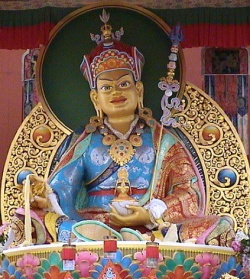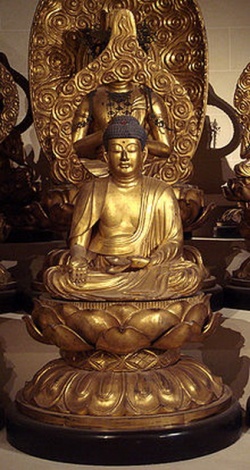Difference between revisions of "The Four Seals of the Dharma"
| Line 4: | Line 4: | ||
| − | In the 26 centuries since the [[life]] of the [[Buddha]], [[Buddhism]] has developed into diverse schools and sects. As [[Buddhism]] reached into new regions of {{Wiki|Asia}} it often absorbed remnants of older regional [[religions]]. [[Many]] local "folk Buddhisms" sprang up that adopted the [[Buddha]] and the [[many]] iconic figures of [[Buddhist]] art and literature as [[gods]], without regard to their original meaning. | + | In the 26 centuries since the [[life]] of the [[Buddha]], [[Buddhism]] has developed into diverse schools and sects. As [[Buddhism]] reached into new regions of {{Wiki|Asia}} it often absorbed remnants of older regional [[religions]]. [[Many]] local "folk Buddhisms" sprang up that adopted the [[Buddha]] and the [[many]] iconic figures of [[Buddhist]] art and {{Wiki|literature}} as [[gods]], without regard to their original meaning. |
Sometimes new [[religions]] sprang up that were [[Buddhist]] in appearance but which retained little of the [[Buddha]]'s teachings. On the other hand, sometimes new schools of [[Buddhism]] arose that approached the teachings in fresh and robust new ways, to the disapproval of [[traditionalists]]. Questions arose -- what is it that distinguishes [[Buddhism]] as a distinctive [[religion]]? When is "[[Buddhism]]" actually [[Buddhism]]? | Sometimes new [[religions]] sprang up that were [[Buddhist]] in appearance but which retained little of the [[Buddha]]'s teachings. On the other hand, sometimes new schools of [[Buddhism]] arose that approached the teachings in fresh and robust new ways, to the disapproval of [[traditionalists]]. Questions arose -- what is it that distinguishes [[Buddhism]] as a distinctive [[religion]]? When is "[[Buddhism]]" actually [[Buddhism]]? | ||
| − | Those schools of [[Buddhism]] based on the [[Buddha]]'s teachings accept the [[Four Seals]] of [[Dharma]] as the distinction between true [[Buddhism]] and "sorta looks like [[Buddhism]]." Further, a teaching that contradicts any of the [[Four Seals]] is not a true [[Buddhist]] teaching. | + | Those schools of [[Buddhism]] based on the [[Buddha]]'s teachings accept the [[Four Seals]] of [[Dharma]] as the distinction between true [[Buddhism]] and "sorta looks like [[Buddhism]]." Further, a [[teaching]] that contradicts any of the [[Four Seals]] is not a true [[Buddhist]] [[teaching]]. |
The [[Four Seals]] are: | The [[Four Seals]] are: | ||
[[File:GuruRinpoche58.jpg|thumb|250px|]] | [[File:GuruRinpoche58.jpg|thumb|250px|]] | ||
| − | All compounded things are [[impermanent]]. | + | All [[compounded]] things are [[impermanent]]. |
All stained [[emotions]] are [[painful]]. | All stained [[emotions]] are [[painful]]. | ||
All [[phenomena]] are [[empty]]. | All [[phenomena]] are [[empty]]. | ||
[[Nirvana]] is [[peace]]. | [[Nirvana]] is [[peace]]. | ||
| − | Let's look at them one at a time. | + | Let's look at them one at a [[time]]. |
| − | 1. All Compounded Things Are [[Impermanent]] | + | 1. All [[Compounded]] Things Are [[Impermanent]] |
| − | Anything that is assembled of other things will come apart -- a toaster, a building, a mountain, a [[person]]. The timetables may vary -- certainly a mountain may remain a mountain for 10,000 years. But even 10,000 years is not "always." The fact is that the [[world]] around us, which seems solid and fixed, is in a state of perpetual flux. | + | Anything that is assembled of other things will come apart -- a toaster, a building, a mountain, a [[person]]. The timetables may vary -- certainly a mountain may remain a mountain for 10,000 years. But even 10,000 years is not "always." The fact is that the [[world]] around us, which seems solid and fixed, is in a state of [[perpetual]] flux. |
Well, of course, you may say. Why is this so important to [[Buddhism]]? | Well, of course, you may say. Why is this so important to [[Buddhism]]? | ||
| − | [[Thich Nhat Hanh]] wrote that [[impermanence]] makes all things possible. Because everything changes, there are seeds and flowers, children and grandchildren. A static [[world]] would be a [[dead]] one. | + | [[Thich Nhat Hanh]] wrote that [[impermanence]] makes all things possible. Because everything changes, there are [[seeds]] and flowers, children and grandchildren. A static [[world]] would be a [[dead]] one. |
[[File:22vnshou.jpg|thumb|250px|]] | [[File:22vnshou.jpg|thumb|250px|]] | ||
| − | [[Mindfulness]] of [[impermanence]] leads us to the teaching of [[dependent origination]]. All the compounded things are part of a limitless web of interconnection that is constantly changing. [[Phenomena]] become because of [[conditions]] created by other [[phenomena]]. [[Elements]] assemble and dissipate and re-assemble. [[Nothing]] is separate from everything else. | + | [[Mindfulness]] of [[impermanence]] leads us to the [[teaching]] of [[dependent origination]]. All the [[compounded]] things are part of a limitless web of interconnection that is constantly changing. [[Phenomena]] become because of [[conditions]] created by other [[phenomena]]. [[Elements]] assemble and dissipate and re-assemble. [[Nothing]] is separate from everything else. |
| − | Finally, being [[mindful]] of the [[impermanence]] of all compounded things, including ourselves, helps us accept loss, [[old age]] and [[death]]. This may seem {{Wiki|pessimistic}}, but it is realistic. There will be loss, [[old age]] and [[death]] whether we accept them or not. | + | Finally, [[being]] [[mindful]] of the [[impermanence]] of all [[compounded]] things, including ourselves, helps us accept loss, [[old age]] and [[death]]. This may seem {{Wiki|pessimistic}}, but it is realistic. There will be loss, [[old age]] and [[death]] whether we accept them or not. |
2. All Stained [[Emotions]] Are [[Painful]]. | 2. All Stained [[Emotions]] Are [[Painful]]. | ||
| − | His Holiness the [[Dalai Lama]] translated this seal "all contaminated [[phenomena]] are of the nature of [[suffering]]." The word "stained" or "contaminated" refers to [[actions]], [[emotions]] and [[thoughts]] conditioned by [[selfish]] [[attachment]], or by [[hate]], [[greed]] and [[ignorance]]. | + | [[His Holiness]] the [[Dalai Lama]] translated this seal "all contaminated [[phenomena]] are of the nature of [[suffering]]." The word "stained" or "contaminated" refers to [[actions]], [[emotions]] and [[thoughts]] [[conditioned]] by [[selfish]] [[attachment]], or by [[hate]], [[greed]] and [[ignorance]]. |
[[Dzongsar Khyentse Rinpoche]], a {{Wiki|Bhutanese}} [[lama]] and filmmaker, said, | [[Dzongsar Khyentse Rinpoche]], a {{Wiki|Bhutanese}} [[lama]] and filmmaker, said, | ||
[[File:201 6544.jpg|thumb|250px|]] | [[File:201 6544.jpg|thumb|250px|]] | ||
| − | "All [[emotions]] are [[pain]]. All of them! Why? Because they involve [[dualism]]. This is a big [[subject]] now. This we have to discuss for a while¦ From the [[Buddhist]] point of [[view]], as long as there is a [[subject]] and [[object]], as long as there is a separation between [[subject]] and [[object]], as long as you divorce them so to speak, as long as you think they are independent and then function as [[subject]] and [[object]], that is an [[emotion]], which includes everything, almost every [[thought]] that we have." | + | "All [[emotions]] are [[pain]]. All of them! Why? Because they involve [[dualism]]. This is a big [[subject]] now. This we have to discuss for a while¦ From the [[Buddhist]] point of [[view]], as long as there is a [[subject]] and [[object]], as long as there is a separation between [[subject]] and [[object]], as long as you divorce them so to speak, as long as you think they are independent and then [[function]] as [[subject]] and [[object]], that is an [[emotion]], which includes everything, almost every [[thought]] that we have." |
| − | It is because we see ourselves as separate from other things that we [[desire]] them, or are repulsed by them. This is the teaching of the [[Second Noble Truth]], which teaches that the [[cause of suffering]] is [[craving]] or [[thirst]] ([[tanha]]). Because we divide the [[world]] into [[subject]] and [[object]], me and everything else, we continually [[grasp]] for things we think are separate from ourselves to make us [[happy]]. But [[nothing]] ever satisfies us for long. | + | It is because we see ourselves as separate from other things that we [[desire]] them, or are repulsed by them. This is the [[teaching]] of the [[Second Noble Truth]], which teaches that the [[cause of suffering]] is [[craving]] or [[thirst]] ([[tanha]]). Because we divide the [[world]] into [[subject]] and [[object]], me and everything else, we continually [[grasp]] for things we think are separate from ourselves to make us [[happy]]. But [[nothing]] ever satisfies us for long. |
3. All [[Phenomena]] Are [[Empty]]. | 3. All [[Phenomena]] Are [[Empty]]. | ||
| − | Another way to say this is that [[nothing]] has intrinsic or inherent [[existence]], including ourselves. This relates to the teaching of [[anatman]], also called [[anatta]]. | + | Another way to say this is that [[nothing]] has intrinsic or inherent [[existence]], including ourselves. This relates to the [[teaching]] of [[anatman]], also called [[anatta]]. |
| − | [[Theravada]] and [[Mahayana]] [[Buddhists]] understand [[anatman]] somewhat differently. [[Theravada]] [[scholar]] [[Walpola Rahula]] explained, | + | [[Theravada]] and [[Mahayana]] [[Buddhists]] [[understand]] [[anatman]] somewhat differently. [[Theravada]] [[scholar]] [[Walpola Rahula]] explained, |
| − | "According to the [[Buddha]]'s teaching, it is as wrong to hold the opinion 'I have no [[self]]' (which is the {{Wiki|annihilationist}} theory) as to hold the opinion 'I have a [[self]]' (the eternalist theory), because both are [[fetters]], both arising out of the false idea 'I AM'. The correct position with regard to the question of [[Anatta]] is not to take hold of any opinion or [[views]], but to try to see things objectively as they are without [[mental]] projections, to see that what we call 'I', or 'being', is only a combination of [[physical]] and [[mental]] [[aggregates]], which are working together interdependently in a flux of momentary [[change]] within the [[law of cause and effect]], and that there is [[nothing]] permanent, everlasting, unchanging and [[eternal]] in the whole of [[existence]]." ([[Walpola Rahula]], What the [[Buddha]] Taught, 2nd ed., 1974, p. 66) | + | "According to the [[Buddha]]'s [[teaching]], it is as wrong to hold the opinion 'I have no [[self]]' (which is the {{Wiki|annihilationist}} {{Wiki|theory}}) as to hold the opinion 'I have a [[self]]' (the eternalist {{Wiki|theory}}), because both are [[fetters]], both arising out of the false [[idea]] 'I AM'. The correct position with regard to the question of [[Anatta]] is not to take hold of any opinion or [[views]], but to try to see things objectively as they are without [[mental]] projections, to see that what we call 'I', or '[[being]]', is only a combination of [[physical]] and [[mental]] [[aggregates]], which are working together interdependently in a flux of momentary [[change]] within the [[law of cause and effect]], and that there is [[nothing]] permanent, everlasting, [[unchanging]] and [[eternal]] in the whole of [[existence]]." ([[Walpola Rahula]], What the [[Buddha]] Taught, 2nd ed., 1974, p. 66) |
| − | [[Mahayana Buddhism]] teaches the [[doctrine]] of [[shunyata]], or "[[emptiness]]." [[Phenomena]] have [[no existence]] of their own and are [[empty]] of a permanent [[self]]. In [[shunyata]], there is neither [[reality]] not not-[[reality]]; only relativity. However, [[shunyata]] also is an [[absolute reality]] that is all things and beings, [[unmanifested]]. | + | [[Mahayana Buddhism]] teaches the [[doctrine]] of [[shunyata]], or "[[emptiness]]." [[Phenomena]] have [[no existence]] of their own and are [[empty]] of a permanent [[self]]. In [[shunyata]], there is neither [[reality]] not not-[[reality]]; only relativity. However, [[shunyata]] also is an [[absolute reality]] that is all things and [[beings]], [[unmanifested]]. |
4. [[Nirvana]] Is [[Peace]]. | 4. [[Nirvana]] Is [[Peace]]. | ||
| Line 53: | Line 53: | ||
[[Dzongsar Khyentse Rinpoche]] said, "In [[many]] [[philosophies]] or [[religions]], the final goal is something that you can hold on to and keep. The final goal is the only thing that truly [[exists]]. But [[nirvana]] is not [[fabricated]], so it is not something to be held on to. It is referred to as 'beyond [[extremes]].'" | [[Dzongsar Khyentse Rinpoche]] said, "In [[many]] [[philosophies]] or [[religions]], the final goal is something that you can hold on to and keep. The final goal is the only thing that truly [[exists]]. But [[nirvana]] is not [[fabricated]], so it is not something to be held on to. It is referred to as 'beyond [[extremes]].'" | ||
| − | [[Nirvana]] is defined in diverse ways by the various schools of [[Buddhism]]. But the [[Buddha]] taught that [[Nirvana]] was beyond [[human]] [[conceptualization]] or [[imagination]], and discouraged his students from wasting time in speculations about [[Nirvana]]. | + | [[Nirvana]] is defined in diverse ways by the various schools of [[Buddhism]]. But the [[Buddha]] taught that [[Nirvana]] was beyond [[human]] [[conceptualization]] or [[imagination]], and discouraged his students from wasting [[time]] in speculations about [[Nirvana]]. |
This Is [[Buddhism]] | This Is [[Buddhism]] | ||
Revision as of 21:25, 29 August 2013
By Barbara O'Brien
In the 26 centuries since the life of the Buddha, Buddhism has developed into diverse schools and sects. As Buddhism reached into new regions of Asia it often absorbed remnants of older regional religions. Many local "folk Buddhisms" sprang up that adopted the Buddha and the many iconic figures of Buddhist art and literature as gods, without regard to their original meaning.
Sometimes new religions sprang up that were Buddhist in appearance but which retained little of the Buddha's teachings. On the other hand, sometimes new schools of Buddhism arose that approached the teachings in fresh and robust new ways, to the disapproval of traditionalists. Questions arose -- what is it that distinguishes Buddhism as a distinctive religion? When is "Buddhism" actually Buddhism?
Those schools of Buddhism based on the Buddha's teachings accept the Four Seals of Dharma as the distinction between true Buddhism and "sorta looks like Buddhism." Further, a teaching that contradicts any of the Four Seals is not a true Buddhist teaching.
The Four Seals are:
All compounded things are impermanent.
All stained emotions are painful.
All phenomena are empty.
Nirvana is peace.
Let's look at them one at a time.
1. All Compounded Things Are Impermanent
Anything that is assembled of other things will come apart -- a toaster, a building, a mountain, a person. The timetables may vary -- certainly a mountain may remain a mountain for 10,000 years. But even 10,000 years is not "always." The fact is that the world around us, which seems solid and fixed, is in a state of perpetual flux.
Well, of course, you may say. Why is this so important to Buddhism?
Thich Nhat Hanh wrote that impermanence makes all things possible. Because everything changes, there are seeds and flowers, children and grandchildren. A static world would be a dead one.
Mindfulness of impermanence leads us to the teaching of dependent origination. All the compounded things are part of a limitless web of interconnection that is constantly changing. Phenomena become because of conditions created by other phenomena. Elements assemble and dissipate and re-assemble. Nothing is separate from everything else.
Finally, being mindful of the impermanence of all compounded things, including ourselves, helps us accept loss, old age and death. This may seem pessimistic, but it is realistic. There will be loss, old age and death whether we accept them or not.
2. All Stained Emotions Are Painful.
His Holiness the Dalai Lama translated this seal "all contaminated phenomena are of the nature of suffering." The word "stained" or "contaminated" refers to actions, emotions and thoughts conditioned by selfish attachment, or by hate, greed and ignorance.
Dzongsar Khyentse Rinpoche, a Bhutanese lama and filmmaker, said,
"All emotions are pain. All of them! Why? Because they involve dualism. This is a big subject now. This we have to discuss for a while¦ From the Buddhist point of view, as long as there is a subject and object, as long as there is a separation between subject and object, as long as you divorce them so to speak, as long as you think they are independent and then function as subject and object, that is an emotion, which includes everything, almost every thought that we have."
It is because we see ourselves as separate from other things that we desire them, or are repulsed by them. This is the teaching of the Second Noble Truth, which teaches that the cause of suffering is craving or thirst (tanha). Because we divide the world into subject and object, me and everything else, we continually grasp for things we think are separate from ourselves to make us happy. But nothing ever satisfies us for long.
3. All Phenomena Are Empty.
Another way to say this is that nothing has intrinsic or inherent existence, including ourselves. This relates to the teaching of anatman, also called anatta.
Theravada and Mahayana Buddhists understand anatman somewhat differently. Theravada scholar Walpola Rahula explained,
"According to the Buddha's teaching, it is as wrong to hold the opinion 'I have no self' (which is the annihilationist theory) as to hold the opinion 'I have a self' (the eternalist theory), because both are fetters, both arising out of the false idea 'I AM'. The correct position with regard to the question of Anatta is not to take hold of any opinion or views, but to try to see things objectively as they are without mental projections, to see that what we call 'I', or 'being', is only a combination of physical and mental aggregates, which are working together interdependently in a flux of momentary change within the law of cause and effect, and that there is nothing permanent, everlasting, unchanging and eternal in the whole of existence." (Walpola Rahula, What the Buddha Taught, 2nd ed., 1974, p. 66)
Mahayana Buddhism teaches the doctrine of shunyata, or "emptiness." Phenomena have no existence of their own and are empty of a permanent self. In shunyata, there is neither reality not not-reality; only relativity. However, shunyata also is an absolute reality that is all things and beings, unmanifested.
4. Nirvana Is Peace.
The fourth seal sometimes is worded "Nirvana is beyond extremes." Walpola Rahula said "Nirvana is beyond all terms of duality and relativity. It is therefore beyond our conceptions of good and evil, right and wrong, existence and non-existence." (What the Buddha Taught, p. 43)
Dzongsar Khyentse Rinpoche said, "In many philosophies or religions, the final goal is something that you can hold on to and keep. The final goal is the only thing that truly exists. But nirvana is not fabricated, so it is not something to be held on to. It is referred to as 'beyond extremes.'"
Nirvana is defined in diverse ways by the various schools of Buddhism. But the Buddha taught that Nirvana was beyond human conceptualization or imagination, and discouraged his students from wasting time in speculations about Nirvana.
This Is Buddhism
The Four Seals reveal what is unique about Buddhism among all the world's religions. Dzongsar Khyentse Rinpoche said, "Whoever holds these four [seals], in their heart, or in their head, and contemplates them, is a Buddhist."



